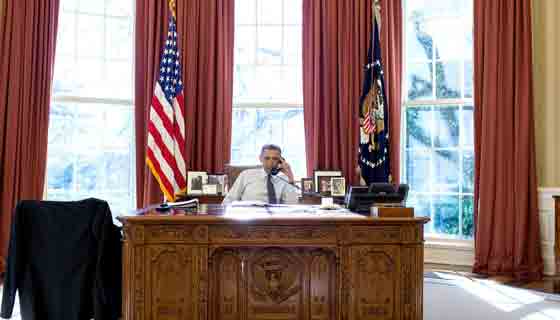China has overtaken the United State to become the world’s largest economy, according to new data and an analysis by the International Monetary Fund.
Calculated by looking at gross domestic product (GDP) alongside cost-of-living data, the IMF announced Tuesday that China is now larger economically than the U.S. for the first time in history with an adjusted GDP of $17.6 trillion compared to a U.S. GDP of $17.4 trillion.
The milestone has been forecast for some time, but the conclusion of the IMF — presented in its 2014 World Economic Outlook report — comes as other economic indicators suggest a global shakeup in the world economy may be upon us. As the Financial Times reports, “the speed of [China’s] transformation” is what’s most” breathtaking” considering that “as recently as 2005, China’s economy was less than half the size of America’s.” Additionally, the IMF now projects that “China’s economy will be 20 percent bigger than that of the U.S. by 2019.”
The BusinessInsider explains how the IMF’s announcement is only based on a certain set of calculations and does not translate to a direct, side-by-side comparison of the two economies:
The simple logic is that prices aren’t the same in each country: A shirt will cost you less in Shanghai than in San Francisco, so it’s not entirely reasonable to compare countries without taking this into account. Though a typical person in China earns a lot less than the typical person in the US, simply converting a Chinese salary into dollars underestimates how much purchasing power that individual, and therefore that country, might have. The Economist’s Big Mac Index is a great example of these disparities.
So the IMF measures both GDP in market-exchange terms and in terms of purchasing power. On the purchasing-power basis, China is overtaking the US right about now and becoming the world’s biggest economy. […]
It’s not all sour news for the US. It’ll be some time yet until the lines cross over in raw terms, not adjusted for purchasing power. By that measure, China still sits more than $6.5 trillion lower than the US and isn’t likely to overtake for quite some time.
As the relative size of world’s largest economies are shifting, so too, are some of the world’s most important economic alliances and institutions. Though the U.S. dollar continues to be the world’s dominant currency and the World Bank and International Monetary Fund both maintain formidable influence on monetary policies, their singular hold on global financial is shifting in numerous ways.
On Wednesday, USA Today reports on ongoing Chinese efforts to have its currency, the renminbi, allowed into the IMF’s Special Drawing Right (known as SDR), a global composite currency system that fosters international trade and maintenance of the world’s top currencies —which currently includes only the U.S. dollar, the British pound, the Japanese Yen, and the Euro. According to the paper:
As the world’s No. 2 economy after the U.S., China believes it is close to earning the status of a reserve money, the first time that an emerging market currency would attain this position. Chinese entry into the “magic circle” has been advanced by the British government’s September decision to issue renminbi-denominated bonds, the first big government to take such a step, and allow the proceeds to be held as reserves by the Bank of England.
The main conditions for the renminbi to pass the SDR test are that it should be widely used in trade and be “freely usable” in international payments and asset management. Although a long way behind the dollar, the renminbi has made impressive strides recently and is challenging the euro in several key fields.
As Conn Hallinan, an analyst who writes for Foreign Policy In Focus, wrote on Tuesday, the rise of emerging of economies—with China the largest and most striking example—the global economic picture is changing in interesting, though not widely understood, ways. According to Hallinan:
This past summer, the BRICS countries—Brazil, Russia, India, China, and South Africa—created an alternative to the largely U.S.-controlled World Bank and International Monetary Fund (IMF), and the Shanghai Cooperation Organization (SCO) added 1.6 billion people to its rolls.
The BRICS’ construction of a Contingent Reserve Arrangement will give its members emergency access to foreign currency, which might eventually dethrone the dollar as the world’s reserve currency. The creation of a development bank will make it possible to bypass the IMF for balance-of-payment loans, thus avoiding the organization’s onerous austerity requirements.
Less than a month after the BRICS’ declaration of independence from the current strictures of world finance, the SCO—which includes China, Russia, Kazakhstan, Kyrgyzstan, Tajikistan, and Uzbekistan—approved India, Pakistan, Iran, and Mongolia for membership in the organization. It was the single largest expansion of the economic cooperation and security-minded group in its history, and it could end up diluting the impact of sanctions currently plaguing Moscow over the Ukraine crisis and Tehran over its nuclear program.
Given the deeply intertwined nature of the economic relationship between the American consumer-based economy and China’s role as the world’s leading manufactuter, the narrative about overall financial strength is never straight-forward.
However, as Hallinan concludes, “the days when the IMF, World Bank, and U.S. Treasury could essentially dictate international finances and intimidate or crush opponents” is swiftly “drawing to a close.”
This article originally appeared on Common Dreams.
————










